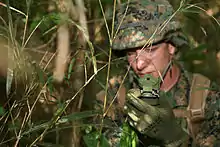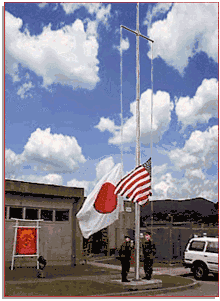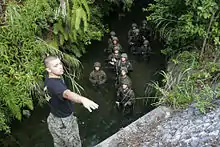Camp Gonsalves
Camp Gonsalves is a U.S. Marine Corps jungle warfare training area established in 1958, and located in northern Okinawa, Japan, across the villages of Kunigami and Higashi. It is the largest U.S training facility in Okinawa. The camp is located in the Yanbaru forest protected area, raising long time ecological concerns enhanced by the 2016 plan to built new helipads.
| Camp Gonsalves Marine Corps Jungle Warfare Training Center | |
|---|---|
 Marine Corps Jungle Warfare Training Center logo | |
| Active | 1958–present |
| Country | |
| Branch | |
| Type | Training Base |
| Size | 8,900 acres (36 km2) |
| Part of | 3rd Marine Division |
| Garrison/HQ | Marine Corps Base Camp Smedley D. Butler |
| Nickname(s) | J Dub |
| Colors | Black and Gold |
| Mascot(s) | Lance Corporal "Millie" Millfred Private Barrett "Bear" 50 Cal Jungle |
| Commanders | |
| Current commander | Maj Jasen L. Hoffman |
| Notable commanders | Lt Gene A. Deegan (1961) Capt Oliver L. North (1973-1974) Capt Steven M. Lowery (1981-1984) Capt Glenn T. Starnes (1986) |
Terrain
Also known as the Northern Training Area (NTA), and since 1998 as the Jungle Warfare Training Center (JWTC) it occupies 17,500 acres (71 km2) of jungle in Northern Okinawa.[1] The hilly and rugged terrain is topped with single and double canopy forest. The region supplies the densely populated south of the island with drinking water. As part of the Ryukyu Islands subtropical evergreen forests, most of the area surrounding JWTC is designated as a national forest by the Government of Japan. The area is home to 24 endangered species including the Okinawa rail, Amami woodcock, Pryers woodpecker and the Ryukyu robin. There are three species of pit viper poisonous snakes, the Okinawa habu, hime habu, and the Sakishima habu. JWTC supports the local Government of Japan small Asian mongoose capturing project.
History
In 1958, the early years of the Vietnam War, the Northern Training Area was established as a counter-guerilla school. Over the years the base camp at NTA gradually evolved from a few Quonset huts and other small buildings to a facility, which was completed in 1984. The Jungle Warfare Training Center contains 22 helicopter landing zones, one water surface beach access, four bivouac sites, three outdoor classrooms, one firebase, three Third World village target sites and one target missile site.
On 5 November 1986, the base camp was officially named Camp Gonsalves, in memory of PFC Harold Gonsalves who was posthumously awarded the Medal of Honor for his heroic actions during the Battle of Okinawa. In March 1998, to better convey NTA as a training base, the name was officially changed to the Marine Corps Jungle Warfare Training Center, the only existing Department of Defense jungle training facility for Marine and Joint Forces. As of March 2000 the area had 71 landowners, with a yearly rental fee of 476 million yen and a total of three Japanese employees.[1]
Takae citizens' sit-in protests
Following various crashes of U.S. military helicopters, including one near Takae district's elementary school, local villagers started a sit-in campaign to block further construction of helipads in the area.[2][3] In 2007 construction officials arrived to start building the new pads, protesters surrounded the trucks and staged a sit-in.[4] After a long stand-off, the prefectural police arrived and ordered the construction to be halted since it was placing the lives of the protesters in danger.[5] Since 2007, approximately 10,000 people have participated in the sit-ins at three sites in the area.[6] In 2008, the Japanese government attempted to serve injunctions against 15 participants, 13 of which were thrown out of court, the remaining two have yet to be decided.[7]
Testing and use of herbicides, chemical, and biological agents were reportedly used on Okinawa in and around the Northern Training Area, including the Yanbaru forest and Kunigami and Higashi villages.[8] Following the 2006 disclosure that the United States military had made widespread use of the defoliant Agent Orange in the jungle training center during the 1960s, local citizens have called for an investigation into the current use of chemical and biological weapons within the camp. The region supplies the densely populated south of the island with drinking water and the impact on long-term health is of grave concern.[9]
The construction of six new helipads has led to increased demonstrations and protests in July 2016.[10][11]
Land reversion
A 1996 agreement included returning 17% of U.S. held land to Japan and building six new helipads at Camp Gonsalves in the Northern Training Area. The project had been on hold due to protests until new construction of the pads was resumed by Japan's Government in mid-2016.[12]
Originally scheduled for December 2008, a fifty-one percent land reversion of the Jungle Warfare Training Center to the Government of Japan was started in 2016. This reversion was not unconditional; conditions for the reversion include building new and expanding existing landing zones in Kunigami and Higashi.[13]
In December 2016 the largest return of land to civilian use since 1972 took place when the U.S. took possession of the new landing pads and returned 9,852 acres (3,987 hectares)s of land it had held since the Second World War.[14] However, "while Tokyo says the reversion will mitigate the burden of Okinawans, critics disagree, saying the deal involves what the U.S. military has called "unusable land" in exchange for new helipads.", according to the Japan Times, who insisted that "from the beginning, the reversion process met fierce opposition from local residents and environmental groups, who cite noise and environmental impact on the forested Yanbaru region."[15]
Military training

A new counterinsurgency school opened in Okinawa in May 1961.[16] Marines had been training for anti-guerrilla operations in the Northern Training Area of Okinawa since at least 1958.[17] The Northern Training Area is operated as the Marine Corps Jungle Warfare Training Center.[17] With the backing of the 3rd Marine Division, JWTC is in a transition of becoming a TECOM (Training and Education Command) school. As of 2017, new courses and curriculum are being developed to include: a Jungle Tracking Course, Jungle Trauma Course, and a Jungle Medicine Course. With the expansion of courses also comes the planning for enclosed classrooms, better teaching equipment, as well as many other various buildings and teaching aids.
Jungle Skills Course

JWTC offers a Jungle Skills Course encompassing basic Marine combat skills in a jungle environment. The course consists of six total days, five of them training days. In addition to basic combat skills in the jungle, the course is designed to enhance the training unit's small unit leadership, tactical mindset, and unit cohesion. Training up to 100 personnel, a few classes taught in the Jungle Skills course are land navigation, patrolling, rope management & rappelling, and jungle booby traps. The Jungle Skills course culminates with the Jungle Endurance Course.

Jungle Leaders
The Jungle Leaders course is designed to develop small unit leaders in all aspects of small-unit combat operations and basic survival skills in the jungle. It combines the previously taught Jungle Survival Course period of instruction with comprehensive basic warfighting skills. To take part in the Jungle Leaders Course, the Jungle Skills Course is a prerequisite. The target of the course is for small unit leaders (team leaders through platoon commanders or equivalent) from any military occupational specialty (MOS). The course consists of six total days consisting of five training days. Training up to 25 personnel, a few classes taught in the Jungle Leaders course are patrol orders, patrolling, jungle casevac (Personnel Extraction), survival skills, defense, and executing patrol bases.

Jungle Endurance Course
The Jungle Endurance Course is the culminating point of the Jungle Skills Course. Classes taught through the five-day Jungle Skills Course are utilized throughout the E-Course. In 12–18-man teams, students traverse 3.8 miles (6.1 km) of dense jungle and rugged terrain. Using teamwork and perseverance, teams compete with one another across 31 obstacles spread along the course. Teams face hasty rappels, rope obstacles, water obstacles and a stretcher carry to complete the entire course.
Independent operations
JWTC offers areas for units to operate independently with prior coordination. Utilizing the areas, units have done Realistic Urban Terrain Exercises (RUTEX), Raids, Non-Combatant Evacuation Operations (NEO), Reconnaissance and Surveillance, Land Navigation, Fast Rope, SPIE Rigging, Communication Exercises, and Water Insertion.
See also
- British Military Garrison Brunei, a UK Army equivalent jungle warfare training site.
References
- GlobalSecurity.org (7 May 2011). "Camp Gonsalves / Okinawa Northern Training Area".
- http://brianandco.cocolog-nifty.com/blog/files/TakaeHelipadCampaign.pdf
- Torio, Lisa. "Can Indigenous Okinawans Protect Their Land and Water From the US Military? | The Nation". The Nation. ISSN 0027-8378. Retrieved 25 August 2018.
- "Protesters, riot police clash in Okinawa as helipad construction resumes - The Mainichi".
- Mitchell, Jon, "Rumbles in the jungle", Japan Times, 19 August 2012, p. 10
- "A Letter from Takae, Okinawa". counterpunch.org. Retrieved 25 August 2018.
- "Takae residents anti-helipad brochure" (PDF).
- Mitchell, Jon. "Agent Orange on Okinawa - New Evidence". The Asia-Pacific Journal. Retrieved 17 February 2013.
- "Takae handout presentation by local association" (PDF).
- "Okinawa assembly adopts statement demanding cancellation of US helipad construction in Takae - @JapanPress_wky".
- "What US citizens can do for TAKAE". www.projectdisagree.org. Retrieved 25 August 2018.
- Kelly, Tim (29 July 2016). "U.S. military prepares for biggest Okinawa land return since 1972". Reuters. Retrieved 14 December 2016.
- McCormack, Gavan; Norimatsu, Satoko Oka (8 March 2018). Resistant Islands: Okinawa Confronts Japan and the United States. Rowman & Littlefield. ISBN 9781538115565.
- Browne, Ryan (6 December 2016). "US returning land to Japan it's controlled since World War II". CNN.com. CNN. Retrieved 14 December 2016.
- Mie, Ayako (21 December 2016). "U.S. return of Okinawa training area faces harsh criticism from local residents". The Japan Times Online. ISSN 0447-5763. Retrieved 25 August 2018.
- Hawkes, Logan. "The Little Known CIA Training Camp of Texas". Retrieved 29 August 2012.
- "Jungle Warfare Training Center". Center for Army Lessons Learned. U.S. Army Center Combined Arms Center. 17 September 2008. Archived from the original on 5 August 2012. Retrieved 17 April 2013.
Links
- "Premiere training ground lies in Okinawa's thick jungle". United States Marine Corps. 24 February 2004. Archived from the original on 27 June 2004.
- Bob Houlihan (August 2003). "Welcome to the Jungle.Flash". All Hands. US Navy.
- "In The Thick of It" (PDF). Marines Magazine. November 1988.
| Wikimedia Commons has media related to Camp Gonsalves. |
.jpg.webp)